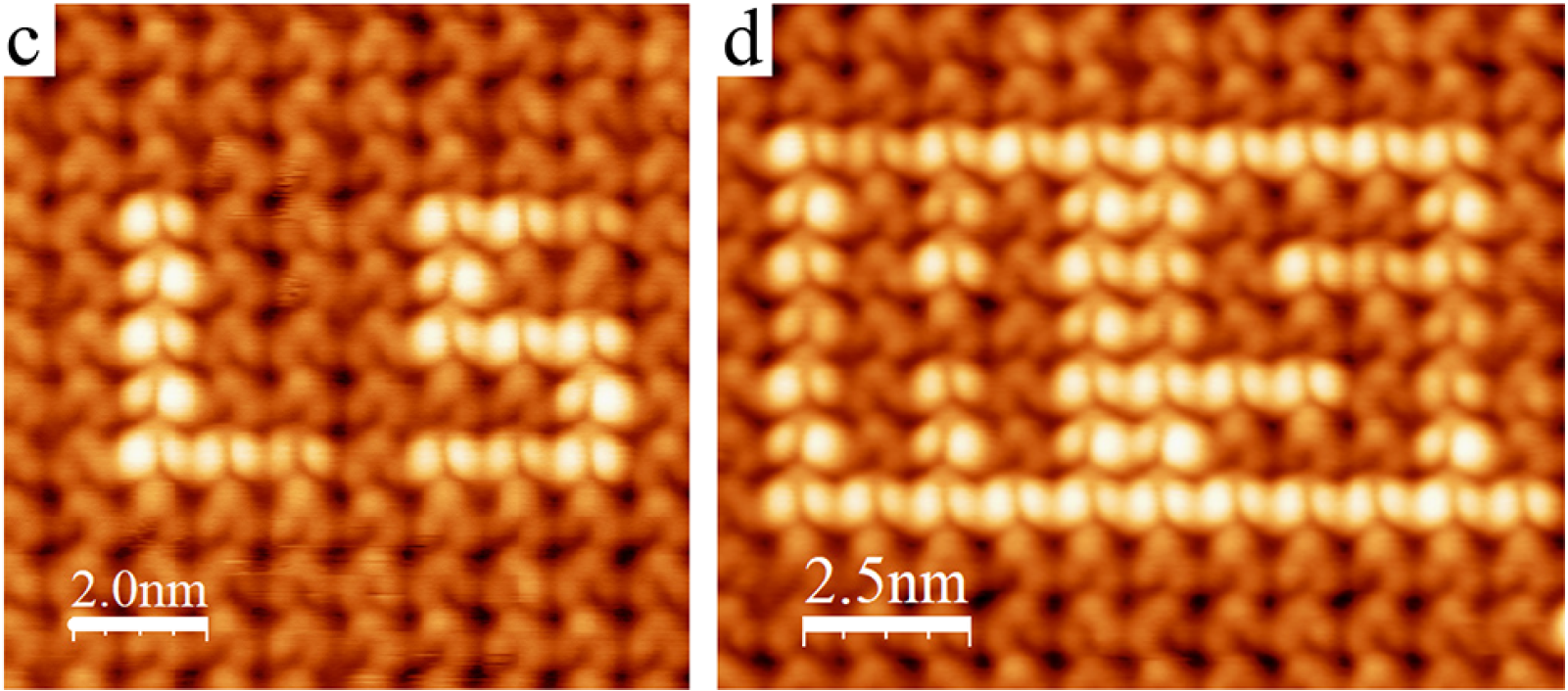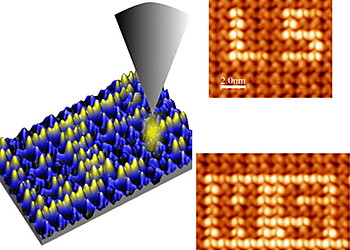Voltage-Induced Bistability of Single Spin-Crossover Molecules in a Two-Dimensional Monolayer
Result of the Month
Here, we demonstrate by scanning tunneling microscopy (STM) measurements the bistability of single SCO molecules self-assembled in a two-dimensional monolayer on Cu(111). This bistability stems from the delicate balance between intermolecular interactions within the monolayer and the interaction between the molecules and the substrate as evidenced by complementary STM measurements and mechano-elastic simulations. We show that the degree of intermolecular cooperativity within a monolayer of SCO molecules is larger when they are adsorbed on Au(111) than on Cu(111). This information is corroborated by the voltage-induced bistability of single molecules evidenced on Cu(111) and absent on Au(111).
The bistability of single spin-crossover molecules in the 2D network developed on Cu(111) have been demonstrated. Parts c and d of Figure 1 present STM images where first all the molecules were switched to the high spin (dark) state, then one by one single molecules were switched back by voltage pulse to the low spin (bright) state to write “HS'’ and ‘'LS” letters. These features have been scanned for 13 hours at a bias voltage of 0.3 V and they remain intact with only few visible defects.

Figure Description: Induced switching by voltage pulses. (c) 10 × 10 nm2 and (d) 10 × 12.5 nm2 topographic images where “LS” and “HS” have been written by voltage pulses at 0.5 V (V = 0.3 V, I = 3 pA, and z varies from 0 to 2.63 Å).
Experimental Methods.
Prior to the molecular deposition, the metallic Cu(111) and Au(111) single crystals are cleaned under ultra high vacuum (UHV, base pressure of 10−10 mbar) by sputtering (Ar+ ions at 600 or 900 eV for Cu(111) or Au(111) respectively) and annealing (450 °C for both substrates) cycles. Molecules FeMPz are then sublimated under UHV at a temperature of 85 °C from a homemade Knudsen-cell-like evaporator on the metallic substrate. During the molecular sublimation the single crystals are kept at low temperature (around 5 K). The samples are then annealed at room temperature to enable the formation of the molecular islands. All the measurements have been carried out on a low temperature scanning tunneling microscope (LT STM, Scienta Omicron) operating at 4.6 K.
Authors
Yongfeng Tong, Massine Kelaï, Kaushik Bairagi, Vincent Repain, Jérôme Lagoute, Yann Girard, Sylvie Rousset, Marie-Laure Boillot, Talal Mallah, Cristian Enachescu, and Amandine Bellec
Institutes
Amandine Bellec − Université de Paris, Laboratoire Matériaux et Phénomènes Quantiques (MPQ), CNRSUMR7162, 75013 Paris, France
Yongfeng Tong − Université de Paris, Laboratoire Matériaux et Phénomènes Quantiques (MPQ), CNRS-UMR7162, 75013 Paris, France
Massine Kelaï − Université de Paris, Laboratoire Matériaux et Phénomènes Quantiques (MPQ), CNRS-UMR7162, 75013 Paris, France
Kaushik Bairagi − Université de Paris, Laboratoire Matériaux et Phénomènes Quantiques (MPQ), CNRS-UMR7162, 75013 Paris, France; Present Address: UniversitéGrenoble Alpes, CEA, CNRS, Grenoble INP, IRIG-SPINTEC, 38054 Grenoble, France
Vincent Repain − Université de Paris, Laboratoire Matériaux et Phénomènes Quantiques (MPQ), CNRS-UMR7162, 75013 Paris, France
Jérôme Lagoute − Université de Paris, Laboratoire Matériaux et Phénomènes Quantiques (MPQ), CNRS-UMR7162, 75013 Paris, France
Yann Girard − Université de Paris, Laboratoire Matériaux et Phénomènes Quantiques (MPQ), CNRS-UMR7162, 75013 Paris, France
Sylvie Rousset − Université de Paris, Laboratoire Matériaux et Phénomènes Quantiques (MPQ), CNRS-UMR7162, 75013 Paris, France
Marie-Laure Boillot − Institut de Chimie Moléculaire et des Matériaux d’Orsay, Université Paris-Saclay, CNRS, UMR 8182, 91405 Orsay Cedex, France
Talal Mallah − Institut de Chimie Moléculaire et des Matériaux d’Orsay, Université Paris-Saclay, CNRS, UMR 8182, 91405 Orsay Cedex, France
Cristian Enachescu − Faculty of Physics, Alexandru Ioan Cuza University of Iasi, Iasi 700506, Romania
-
Corresponding Author
Amandine Bellec − Université de Paris, Laboratoire Matériaux et Phénomènes Quantiques (MPQ), CNRSUMR7162, 75013 Paris, France; Email: amandine.bellec@u-paris.fr

